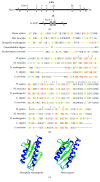Drosophila melanogaster Models of Friedreich's Ataxia
- PMID: 29850527
- PMCID: PMC5907503
- DOI: 10.1155/2018/5065190
Drosophila melanogaster Models of Friedreich's Ataxia
Abstract
Friedreich's ataxia (FRDA) is a rare inherited recessive disorder affecting the central and peripheral nervous systems and other extraneural organs such as the heart and pancreas. This incapacitating condition usually manifests in childhood or adolescence, exhibits an irreversible progression that confines the patient to a wheelchair, and leads to early death. FRDA is caused by a reduced level of the nuclear-encoded mitochondrial protein frataxin due to an abnormal GAA triplet repeat expansion in the first intron of the human FXN gene. FXN is evolutionarily conserved, with orthologs in essentially all eukaryotes and some prokaryotes, leading to the development of experimental models of this disease in different organisms. These FRDA models have contributed substantially to our current knowledge of frataxin function and the pathogenesis of the disease, as well as to explorations of suitable treatments. Drosophila melanogaster, an organism that is easy to manipulate genetically, has also become important in FRDA research. This review describes the substantial contribution of Drosophila to FRDA research since the characterization of the fly frataxin ortholog more than 15 years ago. Fly models have provided a comprehensive characterization of the defects associated with frataxin deficiency and have revealed genetic modifiers of disease phenotypes. In addition, these models are now being used in the search for potential therapeutic compounds for the treatment of this severe and still incurable disease.
Figures




References
-
- Harding A. Clinical features and classification of inherited ataxias. Advances in Neurology. 1993;61:1–14. - PubMed
-
- Bidichandani S. I., Delatycki M. B. Friedreich Ataxia. GeneReviews®. 2017.
Publication types
MeSH terms
Substances
LinkOut - more resources
Full Text Sources
Other Literature Sources
Medical
Molecular Biology Databases
Miscellaneous

